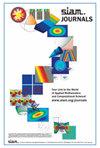A Boundary Integral Equation Method for the Complete Electrode Model in Electrical Impedance Tomography with Tests on Experimental Data
IF 2.3
3区 数学
Q3 COMPUTER SCIENCE, ARTIFICIAL INTELLIGENCE
引用次数: 0
Abstract
SIAM Journal on Imaging Sciences, Volume 17, Issue 1, Page 672-705, March 2024.Abstract. We develop a boundary integral equation–based numerical method to solve for the electrostatic potential in two dimensions, inside a medium with piecewise constant conductivity, where the boundary condition is given by the complete electrode model (CEM). The CEM is seen as the most accurate model of the physical setting where electrodes are placed on the surface of an electrically conductive body, currents are injected through the electrodes, and the resulting voltages are measured again on these same electrodes. The integral equation formulation is based on expressing the electrostatic potential as the solution to a finite number of Laplace equations which are coupled through boundary matching conditions. This allows us to re-express the solution in terms of single-layer potentials; the problem is thus recast as a system of integral equations on a finite number of smooth curves. We discuss an adaptive method for the solution of the resulting system of mildly singular integral equations. This forward solver is both fast and accurate. We then present a numerical inverse solver for electrical impedance tomography which uses our forward solver at its core. To demonstrate the applicability of our results we test our numerical methods on an open electrical impedance tomography data set provided by the Finnish Inverse Problems Society.
电阻抗断层扫描中完整电极模型的边界积分方程法及实验数据测试
SIAM 影像科学杂志》,第 17 卷第 1 期,第 672-705 页,2024 年 3 月。 摘要。我们开发了一种基于边界积分方程的数值方法,用于求解具有片断恒定传导性介质内部的二维静电势,其中边界条件由完整电极模型(CEM)给出。CEM 被视为物理环境中最精确的模型,即在导电体表面放置电极,通过电极注入电流,并在这些相同的电极上再次测量所产生的电压。积分方程公式的基础是将静电势表示为有限个拉普拉斯方程的解,这些方程通过边界匹配条件耦合在一起。这样,我们就可以用单层电势来重新表达解;从而将问题重塑为有限条平滑曲线上的积分方程组。我们讨论了解决由此产生的轻度奇异积分方程组的自适应方法。这种正向求解器既快速又准确。然后,我们介绍了一种用于电阻抗层析成像的数值逆求解器,其核心就是我们的正向求解器。为了证明我们结果的适用性,我们在芬兰反问题协会提供的开放式电阻抗断层成像数据集上测试了我们的数值方法。
本文章由计算机程序翻译,如有差异,请以英文原文为准。
求助全文
约1分钟内获得全文
求助全文
来源期刊

SIAM Journal on Imaging Sciences
COMPUTER SCIENCE, ARTIFICIAL INTELLIGENCE-COMPUTER SCIENCE, SOFTWARE ENGINEERING
CiteScore
3.80
自引率
4.80%
发文量
58
审稿时长
>12 weeks
期刊介绍:
SIAM Journal on Imaging Sciences (SIIMS) covers all areas of imaging sciences, broadly interpreted. It includes image formation, image processing, image analysis, image interpretation and understanding, imaging-related machine learning, and inverse problems in imaging; leading to applications to diverse areas in science, medicine, engineering, and other fields. The journal’s scope is meant to be broad enough to include areas now organized under the terms image processing, image analysis, computer graphics, computer vision, visual machine learning, and visualization. Formal approaches, at the level of mathematics and/or computations, as well as state-of-the-art practical results, are expected from manuscripts published in SIIMS. SIIMS is mathematically and computationally based, and offers a unique forum to highlight the commonality of methodology, models, and algorithms among diverse application areas of imaging sciences. SIIMS provides a broad authoritative source for fundamental results in imaging sciences, with a unique combination of mathematics and applications.
SIIMS covers a broad range of areas, including but not limited to image formation, image processing, image analysis, computer graphics, computer vision, visualization, image understanding, pattern analysis, machine intelligence, remote sensing, geoscience, signal processing, medical and biomedical imaging, and seismic imaging. The fundamental mathematical theories addressing imaging problems covered by SIIMS include, but are not limited to, harmonic analysis, partial differential equations, differential geometry, numerical analysis, information theory, learning, optimization, statistics, and probability. Research papers that innovate both in the fundamentals and in the applications are especially welcome. SIIMS focuses on conceptually new ideas, methods, and fundamentals as applied to all aspects of imaging sciences.
 求助内容:
求助内容: 应助结果提醒方式:
应助结果提醒方式:


